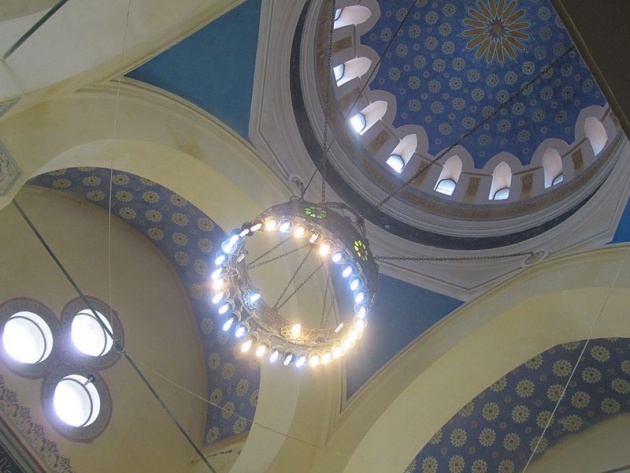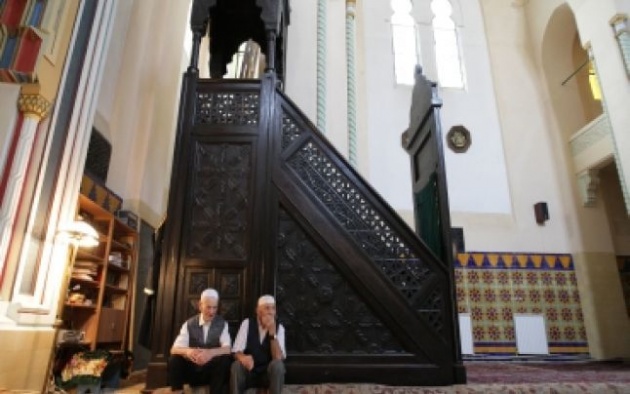Carol I Mosque, one of the architectural monuments of the city of Constanta and an attraction of the numerous tourists who visit this area.
It was rebuilt in 1910 on the orders of King Charles (1866-1914), over an old mosque. Old Mosque Mahmud (named after Sultan Mahmud (1808-1839)), was founded in 1823 by Hafiz Mehmed Pasha.
The inauguration took place Friday, May 31, 1913. Solemnity Sovereigns held in the presence of Romanian King Carol I and Queen Elizabeth (...). A long speech had Constanta County Mufti, Abdul Gelil Hafuz Rifat ensure that the Sovereign "love and devotion Muslim subjects" (cf. dr. Stoica Lascu, "Presence of Turkish-Tatars in the spiritual life of Dobrogea (1913-1915) "in" Tatars in Romanian history "under UDTTMR and the University" Ovidius ", ed. Muntenia, Constanta, 2004).
The new mosque was designed by the great engineer Gogu Constantinescu .
Note that this mosque is the first reinforced concrete building in Romania. Carol Mosque represents a joint Egyptian-Byzantine style with Romanian architectural inlays that make this unique architectural edifice. The pedestal is plated with Dobrogea stone hewn from the old Mahmud mosque keeping only the mihrab worked in the Moorish style. Above the main gate guards the entrance inscription, ' In the name of Allah the Merciful, the Most Merciful ', it represents formula that Muslim believers begin any activity. In the courtyard of the mosque to the right and left of the entrance is the one washed with six taps that serve abdest (ablution) required by Islam.To the right lies the mosque minaret 45 m high in the top of which can be reached via a spiral staircase built of reinforced concrete and counting 140 steps. Room is simple prayer in Islam there are no icons, only ornaments being constituted of several murals in the great dome and four arches. In the background, in the middle of the south wall (toward Mecca) is mihrab where the imam officiating the service. Placing the altar wall of the south (toward Mecca) is determined by a verse from the Koran "Return Mesgid facing the Haram (Kaba)." Around mihrab site are written the 99 attributes of Allah. Right mihrab site is minber where the imam keep the hütbe (sermon) on Friday and weekly service to celebrate special jobs. The left mihrab site is found vaaz Kursu tribune where sermons are held outside of holidays.
Ovidiu Square Mosque combines stylistic elements with other Egyptian and Byzantine Romanian * The place of prayer is unique in terms of architectural Dobrogea * Unlike the orthodox churches or cathedrals Catholic inside the mosque is sober, devoid of any ornaments, statues and religious images .
A few steps away from Ovidiu Square massive and unprecedented rises the silhouette of the mosque Carol I, above which floats like slender minaret and solitary. The foundation stone of the house of prayer to Muslims was made on 24 June 1910 in the presence of numerous assistance with the participation of Minister of Religious Affairs, Spiru Haret, the Ottoman ambassador in Bucharest, Sefa Bey and Ottoman consul in Constanta. The endowment of the Muslim community in Dobrogea with a mosque so great by Romanian Government represent a recognition of faith and devotion to the homeland Muslim inhabitants to Romanian institutions. The new building stands on the trail of an ancient mosque in 1823, built at the expense of Hafuz Hűsseyin Pasha, Sultan Mahmud is dedicated, as the Great Calif. The mosque is a monumental work, which came into specialized textbooks due to the great engineer and inventor Gogu Constantinescu, who first used in the construction of reinforced concrete arch Romania 4-5 cm thin (8 cm by architect Radu Cornescu).Combining stylistic elements with other Egyptian and Byzantine Romanian architect Victor Stefanescu has done first concrete and brick building in the country, unique in Dobrogea in architectural terms.
Climbing the 140 steps of the spiral minaret in that assesses 47 meters, you reach the narrow balcony, where you are offered an incomparable panorama of most of the city. Mihrab rules fully respects Muslim religious buildings being preserved - according to tradition - that of the first chamber, Mahmudiye Mosque in 1822. Unlike the orthodox churches or cathedrals Catholic inside the mosque is sober, devoid of any ornaments, statues and religious images, according to the traditions of Islam. Mihrab, minberul and polychrome decoration door mihrab have yet. In 1965 the mosque was brought from the island of Ada Kaleh a carpet special donation of Sultan Abdul Hamid (1876- 1909) worked in the famous Hereke Handicraft Center in Turkey. The carpet has dimensions of 9 × 16 m, 490kg and 145mp. The inauguration of the mosque is the June 4, 1913 in the presence of a religious delegation arrived in Istanbul. Central Great Mosque or, as is known architectural monument of the city, the main building of the Muslim religion, visited annually by thousands of people, instead of celebrating the holidays, the jobs on Friday, Ramadan Bayram, was repaired in recent years Today is accessible to tourists. The crowning dome with crescent is seen from the sea in good condition.






